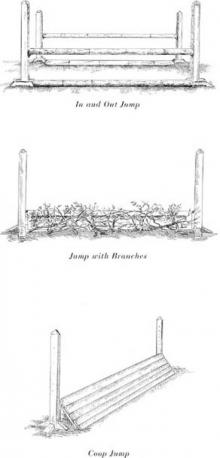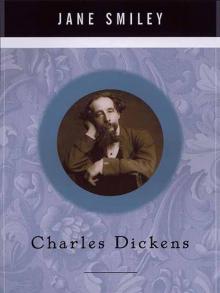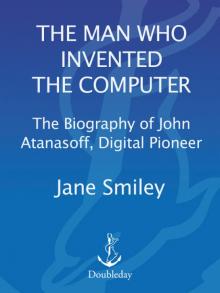- Home
- Jane Smiley
The Man Who Invented the Computer Page 3
The Man Who Invented the Computer Read online
Page 3
Atanasoff was awarded his PhD by the University of Wisconsin in July 1930. He was twenty-six years old and had been married for four years. His daughter, Elsie, was just over a year old and Lura was expecting a second child. His first job offer—assistant professor of mathematics and physics—came from Iowa State. His salary was to be $2,700 dollars per year, $900 more than he had made as a student teacher after receiving his master’s. Jobs in physics were scarce, and Atanasoff once again committed himself to the Iowa State position, only to be subsequently offered a job at Harvard that he once again could not accept.
In 1929, when John Vincent Atanasoff was working on his PhD in physics at the University of Wisconsin, Alan Turing, seventeen (born June 23, 1912), was sitting for his Higher School Certificate examination. The examiner who evaluated his mathematics paper wrote, “He appeared to lack the patience necessary for algebraic verification, and his handwriting was so bad that he lost marks frequently—sometimes because his work was definitely illegible and sometimes his misreading his own writing led him into mistakes.” He had to take this examination three times and switch his major subject from science to mathematics in order to gain acceptance (with a scholarship) to his preferred school, King’s College, Cambridge.
He was already an interesting young man. Turing’s parents, Julius and Ethel, were both born into the English civil service in India. Ethel Stoney’s father was in the medical corps; she was born in Madras and lived most of her life (with occasional trips back to England) in Coonoor. Julius served as a peripatetic official, head assistant collector, near Madras. They met on a ship returning to England by the eastern route, stopping in California. Part of their courtship was a transcontinental journey across the United States, with a sojourn in Yellowstone Park. Alan was born in London in 1912, while his parents were once again on leave. Alan had one older brother, John, born in 1908. Alan was born in Paddington, and then the family settled in the southeast, near Hastings. When Alan was nine months old, his father returned to India. When he was fifteen months old, Ethel followed Julius, leaving John and Alan in the care of a retired army couple. Both parents went back and forth between India and England for the next five years, sometimes together and sometimes separately. They never had a house of their own in England.
Alan was quick as a child and eccentric—he taught himself to read in three weeks, and he had no trouble expressing his opinion. He tended to get caught up in observing things—serial numbers, daisies—but failed to grasp other apparently simple ideas, such as the fact that Christmas came at the same time every year. He was not indulged, and his failure to conform to English (and, no doubt, military and bureaucratic) standards of behavior often led to arguments and tantrums. Descriptions of Alan’s childhood seem to leap out of the writings of Oliver Sacks. The boy was busy, untidy, inventive, inquisitive, and obviously brilliant, but the Turings were bureaucrats—several generations had served as officials in British India. Alan’s mother’s family, the Stoneys, was known to be inventive and commercial—one great-uncle designed sluice gates for water-level control on the Thames and other rivers, while his grandfather worked as chief engineer on the Madras and Southern Mahratta Railway and also designed a type of indoor fan. As bureaucrats, they had status but little money. They had expectations, however, and a class identity to maintain. Much of this maintenance depended on conforming to strict standards of behavior and attending the proper sort of school. Even though Alan readily learned such things as long division and also showed an eager interest in the “underlying principles” of every operation (according to his mother), he did poorly on exams and was always more or less unpopular. He was also sloppy. According to his brother, “It was all the same thing to him which shoe was on which foot.”
Like the young Atanasoff, Turing was enterprising, opinionated, and inquisitive—in Scotland, at age six, he located a beehive by observing where the flight paths of the bees intersected and gathered honey for the family tea. Like Atanasoff, he did not fit into school very well—he pursued his own projects (such as origami and maps), but unlike Atanasoff, he did not care enough to do the assigned work as well as his own projects (or he found it difficult because of such things as poor handwriting). He was terrible at sports and later said that he learned to run fast in order to avoid the ball.
Like Atanasoff, he learned things on his own. One of his favorite books was one he received at the age of ten—Natural Wonders Every Child Should Know, by Edwin Tenney Brewster. In this book, Brewster set out a picture of the natural world that was organized and understandable, as well as scientific and machinelike. Brewster describes the process of evolution and says of the human body, “It really is a gas engine, like the engine of an automobile, a motor boat, or a flying machine.” This machine analogy would prove seminal in Turing’s later work. About the same time, chemistry became his passion, and his family let him pursue various experiments in the basement of the house they were living in.
As Alan approached the age when it was necessary for the Turings to find a public school for him, the problems posed by his eccentricities became more pressing. He took an entrance exam for the school his brother was attending, and was admitted, but John thought life there would be too difficult for him. Eventually, he ended up at the Sherborne School. It was not a good choice. School was not, in the expressed opinion of the Sherborne headmaster A. J. P. Andrews, a place for learning information or developing one’s capacity for critical thinking, but rather where the English class system was to be reinforced and boys to be shown their place within it.
Andrew Hodges writes in his biography that in his first year at Sherborne School, “Alan had no friend, and at least once in this year he was trapped underneath some loose floorboards in the house day-room by the other boys. He tried to continue chemistry experiments there, but this was doubly hated, as showing a swottish mentality, and producing nasty smells.” Alan Turing was from long lines of inventive people on his mother’s side and his father’s side, and he showed a ready and determined fascination with practical things from earliest childhood, but he was repeatedly diverted from these interests by the class system that he was born into and the educational system that was his only route to social respectability. Although, like Atanasoff, and in the manner described by creativity researcher R. Keith Sawyer, Turing persistently looked for problems to solve and then solved them, and also exhibited self-confidence, independence, high energy, willingness to take risks, above-average intelligence, openness to experience, and preference for complexity, his world was not one where he could cultivate these qualities. Iva and John Atanasoff seem to have accepted the fact that, as painful as it could sometimes be to live at the periphery of their society, it was also freeing, and it gave their children valuable experience not only in getting things accomplished, but also in flouting received opinion. The same mode of thinking, and course of action, seems not to have been available to the Turings, and Alan spent his entire youth being balked in his attempts to go his own way. One telling detail is that when he did try his chemistry experiments at Sherborne, they were invariably found and thrown away. The result was that he switched his field, and his thinking, from practical physics to pure mathematics, but he never gave up his interest in machines.
Chapter Two
Atanasoff was now at Iowa State, where his primary responsibility was teaching, not research. Although he might have said that his first love was theoretical physics, or even quantum mechanics, Iowa State did not have a course in quantum mechanics until Atanasoff began teaching one. Atanasoff did have quite a few students, however, and teaching them reminded him over and over of the difficulties of calculation. By all accounts, Atanasoff was a gifted teacher who used an individualized Socratic approach, engaging his students in discussions and questioning them, trying to discover their areas of expertise and ignorance. He saw over and over that all scientific and engineering progress would be retarded until some sort of breakthrough in methods of calculation. He also employed his students in i
nvestigating ways of calculating. One of these students came up with an idea for a type of small analog calculator, something like a slide rule, that measured fourteen inches by three inches by three inches. Atanasoff, the student, and another colleague designed it to calculate the geometry of surfaces and called it a “Laplaciometer,” after the eighteenth-century French mathematician and astronomer Pierre-Simon Laplace, but its uses were limited.
Most calculators in the 1930s were analog, that is, they were similar to a slide rule in that something is measured in order to ascertain a number. As Atanasoff later explained to Clark Mollenhoff, his first biographer, the thing measured “can be anything: a distance, an electric voltage, a current of electricity, air pressure, etc.” Calculating ever larger numbers requires ever more sensitive measurements, so that, for example, a slide rule, which calculates numbers by measuring distance, would have to be enormous (“the length of a football field, or in some instances a mile or more”) in order to represent the numbers Atanasoff was interested in calculating.
One famous analog calculator that Atanasoff read about in the thirties was the Bush Differential Analyzer, developed in 1927–31 at MIT by Vannevar Bush, who had already founded the company that was to become Raytheon and would later head the National Defense Research Committee and the Office of Scientific Research and Development (which was in charge of what would become the Manhattan Project from 1941 until it was taken over by the army in 1943). The Differential Analyzer may be pictured as an automobile gearing mechanism used for calculation. It was “in essence a variable-speed gear, and took the form of a rotating horizontal disk on which a small knife-edged wheel rested. The wheel was driven by friction, and the gear ratio was altered by varying the distance of the wheel from the axis of rotation of the disk.” What was measured (as the slide rule measures distance) were the various positions of the shaft as it turned. These positions were assigned values like the numbers on a slide rule.
When, in 1936, Atanasoff and his colleagues decided that the possibilities of the Laplaciometer were limited, Atanasoff turned his attention to what might be done with the Monroe calculator, the same typewriter-like machine he had used at the University of Wisconsin when he was doing the math for his dissertation. The solution he thought up was similar to the mechanically based solutions others were trying, such as linking thirty machines and thereby enlarging their capacity. But enlarging capacity did not change the theory behind calculation—adding and subtracting remained the essential operations. Atanasoff did not have access to thirty machines, though. Instead, he got together with an Iowa State colleague, statistics professor A. E. Brandt, whom he had first met as a student in 1925. Brandt had access to a single IBM tabulator owned by the statistics department.
In the mid-1930s, IBM was a fairly new company, the product of several mergers, but having its origins in the Tabulating Machine Company, which had been founded in 1896 by inventor Herman Hollerith—his first model had been used in the census of 1900. In 1911, several companies joined to form the CTR (Computing Tabulating Recording) Corporation, which offered a wide range of services to businesses—calculating, but also timekeeping and meat-slicing (a product called the Dayton Safety Electric Meat Chopper—the division was sold to Hobart Manufacturing Company in 1934). Thomas J. Watson, Sr., had become president in 1915, and the name of the company was changed to International Business Machines in 1924. In 1928, IBM introduced the standard eighty-column punch card (the Hollerith card) that came to be familiar to students and secretaries for decades afterward. A 1931 model, developed for and used solely by the Columbia University Statistical Bureau to tabulate results of observations and experiments made at Columbia, seemed exciting at the time—one astronomer declared himself thrilled just watching how quickly the machine went through its additions and subtractions.
The less advanced device Atanasoff and Brandt decided to modify looked more like an upright piano than a desk calculator and operated in the customary Hollerith/IBM fashion, by reading a deck of punched cards and adding or subtracting the values represented by holes in the cards. With the help of IBM representatives, Atanasoff and Brandt modified the Iowa State–owned version of the tabulator in several significant ways and published an article about their product in 1936 in the Journal of the Optical Society of America entitled “Application of Punched Card Equipment to the Analysis of Complex Spectra.” It reads rather dryly, but what Atanasoff and Brandt were really doing was something Atanasoff had been doing since childhood—fiddling with a machine and redesigning it in order to get it to perform in a better or faster or more complex way. At the end of the article abstract is the line “The advantages of the method include high speed, accuracy as high as desired without checking with an adding machine, and the fact that only one simple modification is needed of standard equipment that is available almost everywhere.” According to Mollenhoff’s biography of Atanasoff, while IBM representatives cooperated with Atanasoff and Brandt in modifying the IBM calculator that they were using, IBM internal memorandums at the time were highly critical of Atanasoff and Brandt for “meddling with the tabulators and using them in ways the corporation officials had not intended that they be used.” According to Tammara Burton, who may have heard it from her grandfather, the memo said, “Keep Atanasoff out of the IBM tabulator.”
IBM was jealous of its intellectual property, something that another computer innovator was also discovering. If Atanasoff had ended up at Harvard, he might have met Howard H. Aiken (born March 8, 1900), whom he also might have met at the University of Wisconsin. Aiken, too, was eager to develop a calculating machine that would solve differential equations, and Aiken was not unlike Atanasoff in other ways—he had put himself through high school while working at the local electric company in Indianapolis and then through the University of Wisconsin (at precisely the same time that Atanasoff was putting himself through the University of Florida) by working at the gas company in Madison. After earning his bachelor’s degree, he worked in the private sector before going to the University of Chicago and then to Harvard for his master’s and his PhD. His dissertation, “Theory of Space Charge Conductions,” was similar to “The Dielectric Constant of Helium”—it considered “the properties of vacuum tubes—devices in which electric currents are passed across an empty space between two metal contacts.” Like Atanasoff, Aiken was exhausted by the calculations required to prove his thesis, or, as his biography puts it, “The mathematical complexities involved in describing space charge conduction made calculating solutions to his problems impossible.” While Atanasoff was pondering the Laplaciometer, Aiken, at Harvard, was trying to conceive of a way to improve Charles Babbage’s original Difference Engine. Harvard offered Aiken even less support than Atanasoff found at Iowa State College—in fact, President Conant actively discouraged him. Aiken then approached several mechanical calculating machine companies without success.
Most computer inventors in the 1930s, including Vannevar Bush and Howard Aiken, were convinced that the future of computing lay in its past—in the theories of Charles Babbage (1791–1871), who had begun laying out his ideas for a mechanical calculator in 1822 and proposed constructing it to the Royal Astronomical Society. It was an analog device, designed to solved polynomial equations using shafts and toothed gears. Babbage worked on it for twenty-five years, redesigning it at least once, but nineteenth-century machining wasn’t up to the precision of the task, and the Difference Engine never really worked. Even so, Babbage grew more ambitious and designed a machine he called the Analytical Engine. All of the twentieth-century computer inventors were aware of Babbage’s work (except Konrad Zuse, isolated in Germany). Howard Aiken proposed to update Babbage’s ideas with more modern industrial techniques—the machining of gears and shafts had advanced considerably in the hundred years since Babbage’s time. His Mark I was to be a relay-switch-based computer. And it was to be huge. It was to be built of
a power supply and electric motor for driving the machine; four master control panels
, controlled by instructions on punched rolls of paper tape and synchronized with the rest of the machine; manual adjustments for controlling the calculation of functions; 24 sets of switches for entering numerical constants; 2 paper tape readers for entering additional constants; a standard punched card reader; 12 temporary storage units; 5 units each—add/subtract, multiply, divide; various permanent function tables (e.g. sine, cosine, etc.); accumulators; and printing and card punching equipment. All of these components should be built to accommodate figures up to 23 digits long. Finally, Aiken estimated the speed of the calculator based upon the speed of contemporary IBM machines, 750 8-digit multiplications per hour, representing a vast increase in speed and accuracy over manual methods of calculation.
It used a decimal number system, and even though Aiken had done his dissertation on vacuum tubes, his was a mechanical switching system.
At some point, perhaps reflecting on his efforts to get his computer built, Aiken is said to have remarked, “Don’t worry about people stealing your ideas. If your ideas are any good, you’ll have to ram them down people’s throats.” Perhaps in this, too, Aiken would have found a sympathetic listener in Atanasoff.

 The Georges and the Jewels
The Georges and the Jewels Pie in the Sky: Book Four of the Horses of Oak Valley Ranch
Pie in the Sky: Book Four of the Horses of Oak Valley Ranch Duplicate Keys
Duplicate Keys Charles Dickens
Charles Dickens Good Faith
Good Faith Private Life
Private Life A Thousand Acres: A Novel
A Thousand Acres: A Novel The Greenlanders
The Greenlanders Ten Days in the Hills
Ten Days in the Hills Gee Whiz: Book Five of the Horses of Oak Valley Ranch
Gee Whiz: Book Five of the Horses of Oak Valley Ranch A Thousand Acres
A Thousand Acres The All-True Travels and Adventures of Lidie Newton
The All-True Travels and Adventures of Lidie Newton Ordinary Love and Good Will
Ordinary Love and Good Will Taking the Reins (An Ellen & Ned Book)
Taking the Reins (An Ellen & Ned Book) The Man Who Invented the Computer
The Man Who Invented the Computer Horse Heaven
Horse Heaven The Age of Grief
The Age of Grief Riding Lessons
Riding Lessons Perestroika in Paris
Perestroika in Paris A Good Horse: Book Two of the Horses of Oak Valley Ranch
A Good Horse: Book Two of the Horses of Oak Valley Ranch Saddles & Secrets (An Ellen & Ned Book)
Saddles & Secrets (An Ellen & Ned Book) Some Luck: A Novel
Some Luck: A Novel Champion Horse
Champion Horse Some Luck
Some Luck Gee Whiz
Gee Whiz Barn Blind
Barn Blind A Thousand Acres (1992 Pulitzer Prize)
A Thousand Acres (1992 Pulitzer Prize) Pie in the Sky
Pie in the Sky True Blue
True Blue A Thousand Acres_A Novel
A Thousand Acres_A Novel A Good Horse
A Good Horse